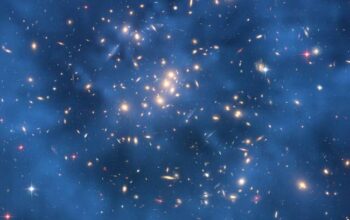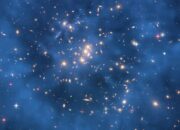Quasars, or quasi-stellar objects, represent some of the most enigmatic phenomena in the cosmos. Most commonly regarded as powerful beacons of light heralding the presence of supermassive black holes at the centers of distant galaxies, quasars embody a conundrum that juxtaposes their role as incandescent light shows against their potential as star-forming engines. This intricate duality prompts a reevaluation of the fundamental mechanisms that govern their existence and influence the surrounding universe.
To understand quasars and their implications in cosmology, one must first delve into their operational mechanics. Quasars are powered by the accretion of matter falling into supermassive black holes, which can attain masses millions to billions of times that of our sun. As matter spirals into these gravitational maelstroms, it heats up due to immense friction and pressure, emitting an extraordinary spectrum of electromagnetic radiation, particularly in the visible, ultraviolet, and sometimes even gamma-ray wavelengths. The result is a luminous object that can outshine entire galaxies.
This luminosity allows quasars to be observed at astonishing distances, effectively rendering them cosmic beacons that illuminate the early universe. The study of quasars offers unique insights into the formation and evolution of galaxies, as their brightness makes them discernible across vast expanses of time and space. Consequently, they serve as valuable tools for probing the cosmic landscape, providing a glimpse into the conditions prevailing at the dawn of cosmic time.
However, the observation of quasars is not merely an exercise in astronomy but also prompts deeper questions about the processes at play. Are they merely markers for black holes, or do they also influence their host galaxies in profound ways? Recent research suggests that quasars may be not solely passive observers in the cosmological narrative but potentially act as catalysts for star formation within their respective galaxies.
The interplay between quasars and their host galaxies can be likened to a cosmic feedback loop. The energy and radiation emitted by a quasar can drive powerful outflows of gas and dust, influencing the star formation rates within the galactic environment. The immense energy released during quasar activity can compress and heat surrounding gas, triggering star formation in regions that would otherwise remain dormant. This phenomenon poses a transformative shift in our understanding of how galaxies evolve, suggesting that quasars may not be mere byproducts of galactic evolution but rather active participants in shaping their environments.
One compelling aspect of studying quasars is their relationship with the cosmic web, an extensive structure formed by dark matter and gas in the universe. The cosmic web consists of vast filaments that connect galaxies and clusters of galaxies, resembling a grand, filamentous network. Quasars, positioned within this intricate architecture, can be instrumental in illuminating the dynamics of the cosmic web. As quasars illuminate the filaments connecting galaxies, they contribute to our understanding of matter distribution and the underlying processes governing the large-scale structure of the universe.
Furthermore, investigating the origins and evolution of quasars opens new avenues in our comprehension of cosmic history. Researchers have noted that many quasars appear to be associated with significant star formation occurring in their host galaxies. This correlation raises intriguing questions about the timeline of galactic evolution. Does quasar activity precede, coincide with, or follow significant periods of star formation? Delving into this question may provide essential insights into the life cycles of galaxies and the conditions conducive to their growth.
Accompanying this inquiry is the awareness that quasars serve as cosmic standard candles. Their unique luminosity profiles and spectral features allow astronomers to derive distances and trace the expansion rate of the universe. This aspect of quasars extends beyond mere supervision of stellar phenomena; it places quasars at the forefront of cosmological research. They bridge gaps across epochs, linking the relatively recent cosmic time frame with events occurring billions of years ago, thus enabling a more cohesive narrative concerning the universe’s evolution.
Yet, despite the advancing understanding of quasars, numerous uncertainties and complexities remain. Questions surrounding their formation, longevity, and the precise mechanisms governing their interaction with their host galaxies and surroundings are still under vigorous investigation. The tantalizing possibility that quasars may facilitate star formation introduces a layer of complexity that challenges existing paradigms about the interplay between active galactic nuclei and their host systems.
In conclusion, quasars epitomize a fascinating domain within modern astrophysics, embodying both cosmic light shows and possible star-making factories. Their ability to illuminate distant galactic structures while potentially influencing star formation within their hosts situates them at a crucial intersection of cosmological and stellar evolution studies. Future research, equipped with advanced observational techniques and theoretical models, will likely continue to unveil the profound implications of these celestial objects. As we deepen our understanding of quasars, we inch closer to unraveling the intricate tapestry of the universe and our place within it. The ongoing exploration of quasars promises not only to satisfy our curiosity but also to shift our perspective on the cosmos, illuminating the enigmatic processes that shape galaxies and stellar systems through time.










